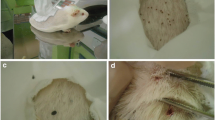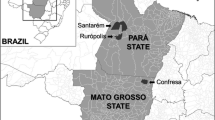Abstract
A Senegalese isolate of the rickettsiaCowdria ruminantium was transmitted transstadially by nymphs of the American reptile tickAmblyomma dissimile. Only eight nymphs, fed as larvae on a Saanen goat reacting to heartwater, were required to transmit fatal heartwater to another susceptible goat.
SinceA. dissimile usually feeds on snakes, iguanas and lizards in central America, the tick is not considered to play a significant role in the transmission of heartwater between ruminants. However, the tick could play a role in maintaining a rickettsial reservoir in reptile populations, since it has been shown that an African reptile can be a subclinical carrier ofC. ruminantium, infective to vector ticks.
Similar content being viewed by others
References
Bezuidenhout, J.D., 1987. Natural transmission of heartwater. Onderstepoort J. Vet. Res., 54: 349–351.
Doss, M.A., Farr, M.M., Roach, K.F. and Anastos, G., 1974. Catalogue of Medical and Veterinary Zoology, Special Publication No. 3. Ticks and Tickborne Diseases. 1. Genera and Species of Ticks, 1: 48–51.
Jones, E.K., Clifford, C.M., Keirans, J.E. and Kohls, G.M., 1972. The ticks of Venezuela (Acarina: Ixodoidea) with a key to the species ofAmblyomma in the Western hemisphere. Brigham Young University Science Bulletin, Vol. XVII, No. 4.
Jongejan, F., 1991. Protective immunity to heartwater (Cowdria ruminantium infection) is acquired after vaccination with in vitro-attenuated rickettsiae. Infect. Immun., 75: 3243–3246.
Jongejan, F., Uilenberg, G., Franssen, F.F.J., Gueye, A. and Nieuwenhuijs, J., 1988. Antigenic differences between stocks ofCowdria ruminantium. Res. Vet. Sci., 44: 186–189.
Jongejan, F., Thielemans, M.J.C., De Groot, M., Van Kooten, P.J.S. and Van Der Zeijst, B.A.M., 1991. Competitive enzyme-linked immunosorbent assay for heartwater using monoclonal antibodies to aCowdria ruminantium-specific 32-kilodalton protein. Vet. Microbiol., 28: 199–211.
Muller Kobold, A., Martinez, D., Camus, E. and Jongejan, F., 1992. Distribution of heartwater in the Caribbean based on detection of antibodies to the conserved 32-kilodalton protein ofCowdria ruminantium. J. Clin. Microbiol. (in press).
Petney, T.N., Horak, I.G. and Rechav, Y., 1987. The ecology of the African vectors of heartwater, with particular reference toAmblyomma hebraeum andAmblyomma variegatum. Onderstepoort J. Vet. Res., 54: 381–395.
Uilenberg, G., 1982. Experimental transmission ofCowdria ruminantium by the Gulf Coast tickAmblyomma maculatum: danger of introducing heartwater and benign African theileriasis onto the American mainland. Am. J. Vet. Res., 43: 1279–1282.
Uilenberg, G., 1983. Heartwater (Cowdria ruminantium infection): current status. Adv. Vet. Sci. Comp. Med., 27: 427–480.
Uilenberg, G., 1990. Extension de la tiqueAmblyomma variegatum dans les Antilles; comment expliquer cette grave menace et que faire? Rev. Elev. Méd. Vét. Pays Trop., 43: 297–299.
Author information
Authors and Affiliations
Rights and permissions
About this article
Cite this article
Jongejan, F. Experimental transmission ofCowdria ruminantium (Rickettsiales) by the American reptile tickAmblyomma dissimile Koch, 1844. Exp Appl Acarol 15, 117–121 (1992). https://doi.org/10.1007/BF01275522
Received:
Issue Date:
DOI: https://doi.org/10.1007/BF01275522




